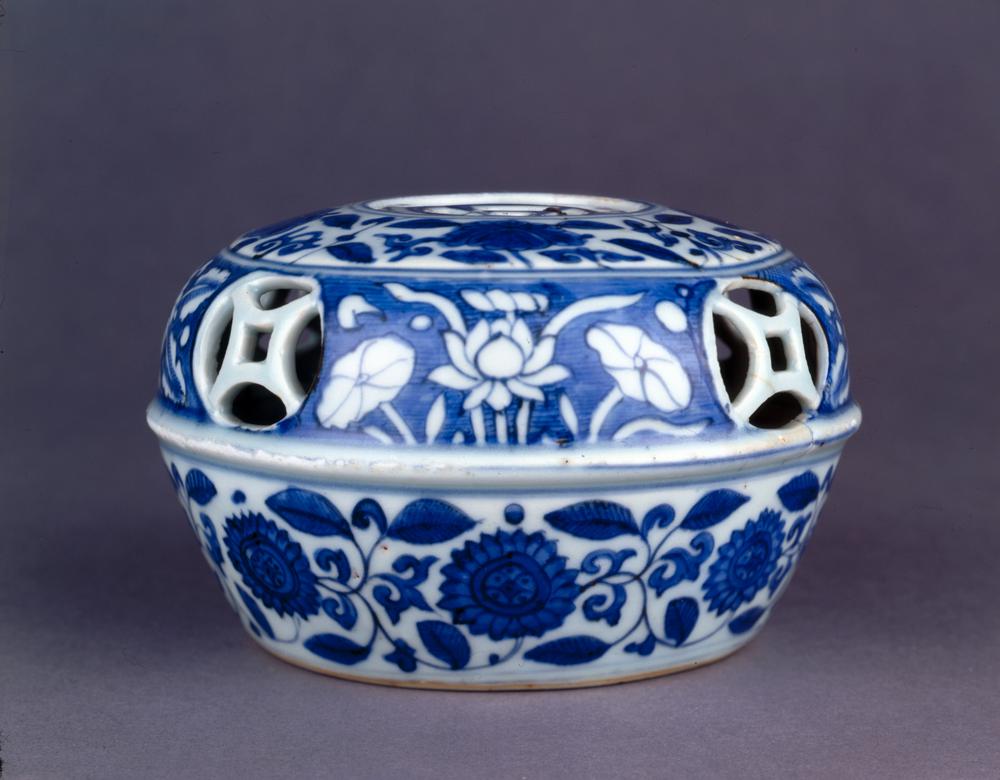Period:Five Dynasties and Ten Kingdoms Production date:10thC
Materials:silk, 絲綢 (Chinese),
Technique:painted
Subjects:bodhisattva lotus bamboo willow 菩薩 (Chinese) 蓮花 (Chinese) 供養人 (Chinese) 竹子 (Chinese) 柳枝 (Chinese)
Dimensions:Height: 70.50 centimetres Width: 55 centimetres
Description:
Painting of Avalokiteśvara seated on a rock in a lotus pool, with a round “moon” halo behind him. He holds a willow-branch and a vase, and is flanked by bamboos. The water is separated from the banks by zig-zag lines, but appears to be higher than the land around it. Four donor figures in the lower section, with blank cartouches in the centre. Ink and colour on silk.
IMG
![图片[1]-painting; 繪畫(Chinese) BM-1919-0101-0.29-China Archive](https://chinaarchive.net/Five Dynasties and Ten Kingdoms/Paintings/mid_00000257_001.jpg)
![图片[2]-painting; 繪畫(Chinese) BM-1919-0101-0.29-China Archive](https://chinaarchive.net/Five Dynasties and Ten Kingdoms/Paintings/mid_29.jpg)
![图片[3]-painting; 繪畫(Chinese) BM-1919-0101-0.29-China Archive](https://chinaarchive.net/Five Dynasties and Ten Kingdoms/Paintings/mid_RFC632.jpg)
Comments:EnglishFrom Whitfield 1983:The subject of the water-moon Guanyin is specifically identified in a painting dated A.D. 943 天福八年 in the Pelliot collection (Bannieres, No. 101), in a panel opposite the donor below an elaborately executed Thousand-armed Avalokitesvara. There, however, the figure is simply set against a rising full moon, while in this picture the aureole is banded, and there is in addition a nimbus behind the head. Stein painting 15 (Pl. 52), on paper, is closer to the formula of the Pelliot painting. In all three representations, Avalokitesvara holds the willow branch in one hand and a small vase in the other, and is flanked by bamboos.As in the following plate, the costumes of the donors suggest a date no earlier than the middle of the tenth century. There are other resemblances as well, such as the way in which the narrow cartouches intended for the names of the donors are placed right alongside that for the principal inscription. The same lack of sophistication is visible in the execution of the setting for Avalokitesvara. The Bodhisattva is seated with one leg pendent, on a rocky pedestal which emerges from a lotus pool. The pool has the familiar zig-zag banks with modeling strokes in ink, but, unable to cope with the problems of delimiting the grassy top from the white edges, the painter has simply reversed the latter, so that the water, if strictly interpreted, would appear to be higher than the banks which contain it. The problem is solved correctly in the Pelliot painting earlier referred to. ChineseFrom Whitfield 1983:關於“水月觀音”這一主題,在伯希和收藏品的有天福八年(943年)紀年的華麗的《千手千眼觀音圖》(參照伯希和圖錄《敦煌的幡和繪畫》篇圖版101)的下欄左側的長方形題箋中有明確記錄。但與那背後只繪一輪滿月的像相比,本圖的像卻加了同心圓的條狀頭光和背光。這一點,在後面介紹的紙繪《水月觀音圖》(參照圖52)與伯希和收集品的繪畫更接近。三件中,觀音都是一手執小柳枝,一手持淨瓶,周圍環繞著竹子。與下圖(圖20)相同,供養人的服飾表明這些畫不會早於10世紀中葉。與下圖還有其它相似點,比如記錄供養人名題記的細長方形題箋連接著中央的題記欄等,另外,對觀音的描繪同樣缺乏成熟的技法。此菩薩半跏趺姿勢,坐在漂浮于蓮池中的岩座上。蓮池有通常的鋸齒狀的岸邊,但若仔細觀察,水面和草叢的關係卻錯了位。那是因爲,從白色立起的岸邊到生長草叢的陸地部分沒有處理好,簡單地顛倒了峭立的斷面的緣故。上面所述對這部分的描繪,在伯希和收集品的《水月觀音圖》中是正確的。
Materials:silk, 絲綢 (Chinese),
Technique:painted
Subjects:bodhisattva lotus bamboo willow 菩薩 (Chinese) 蓮花 (Chinese) 供養人 (Chinese) 竹子 (Chinese) 柳枝 (Chinese)
Dimensions:Height: 70.50 centimetres Width: 55 centimetres
Description:
Painting of Avalokiteśvara seated on a rock in a lotus pool, with a round “moon” halo behind him. He holds a willow-branch and a vase, and is flanked by bamboos. The water is separated from the banks by zig-zag lines, but appears to be higher than the land around it. Four donor figures in the lower section, with blank cartouches in the centre. Ink and colour on silk.
IMG
![图片[1]-painting; 繪畫(Chinese) BM-1919-0101-0.29-China Archive](https://chinaarchive.net/Five Dynasties and Ten Kingdoms/Paintings/mid_00000257_001.jpg)
![图片[2]-painting; 繪畫(Chinese) BM-1919-0101-0.29-China Archive](https://chinaarchive.net/Five Dynasties and Ten Kingdoms/Paintings/mid_29.jpg)
![图片[3]-painting; 繪畫(Chinese) BM-1919-0101-0.29-China Archive](https://chinaarchive.net/Five Dynasties and Ten Kingdoms/Paintings/mid_RFC632.jpg)
Comments:EnglishFrom Whitfield 1983:The subject of the water-moon Guanyin is specifically identified in a painting dated A.D. 943 天福八年 in the Pelliot collection (Bannieres, No. 101), in a panel opposite the donor below an elaborately executed Thousand-armed Avalokitesvara. There, however, the figure is simply set against a rising full moon, while in this picture the aureole is banded, and there is in addition a nimbus behind the head. Stein painting 15 (Pl. 52), on paper, is closer to the formula of the Pelliot painting. In all three representations, Avalokitesvara holds the willow branch in one hand and a small vase in the other, and is flanked by bamboos.As in the following plate, the costumes of the donors suggest a date no earlier than the middle of the tenth century. There are other resemblances as well, such as the way in which the narrow cartouches intended for the names of the donors are placed right alongside that for the principal inscription. The same lack of sophistication is visible in the execution of the setting for Avalokitesvara. The Bodhisattva is seated with one leg pendent, on a rocky pedestal which emerges from a lotus pool. The pool has the familiar zig-zag banks with modeling strokes in ink, but, unable to cope with the problems of delimiting the grassy top from the white edges, the painter has simply reversed the latter, so that the water, if strictly interpreted, would appear to be higher than the banks which contain it. The problem is solved correctly in the Pelliot painting earlier referred to. ChineseFrom Whitfield 1983:關於“水月觀音”這一主題,在伯希和收藏品的有天福八年(943年)紀年的華麗的《千手千眼觀音圖》(參照伯希和圖錄《敦煌的幡和繪畫》篇圖版101)的下欄左側的長方形題箋中有明確記錄。但與那背後只繪一輪滿月的像相比,本圖的像卻加了同心圓的條狀頭光和背光。這一點,在後面介紹的紙繪《水月觀音圖》(參照圖52)與伯希和收集品的繪畫更接近。三件中,觀音都是一手執小柳枝,一手持淨瓶,周圍環繞著竹子。與下圖(圖20)相同,供養人的服飾表明這些畫不會早於10世紀中葉。與下圖還有其它相似點,比如記錄供養人名題記的細長方形題箋連接著中央的題記欄等,另外,對觀音的描繪同樣缺乏成熟的技法。此菩薩半跏趺姿勢,坐在漂浮于蓮池中的岩座上。蓮池有通常的鋸齒狀的岸邊,但若仔細觀察,水面和草叢的關係卻錯了位。那是因爲,從白色立起的岸邊到生長草叢的陸地部分沒有處理好,簡單地顛倒了峭立的斷面的緣故。上面所述對這部分的描繪,在伯希和收集品的《水月觀音圖》中是正確的。
© Copyright
The copyright of the article belongs to the author, please keep the original link for reprinting.
THE END
![[Qing Dynasty] British female painter—Elizabeth Keith, using woodblock prints to record China from the late Qing Dynasty to the early Republic of China—1915-China Archive](https://chinaarchive.net/wp-content/uploads/2022/11/image-191x300.png)




